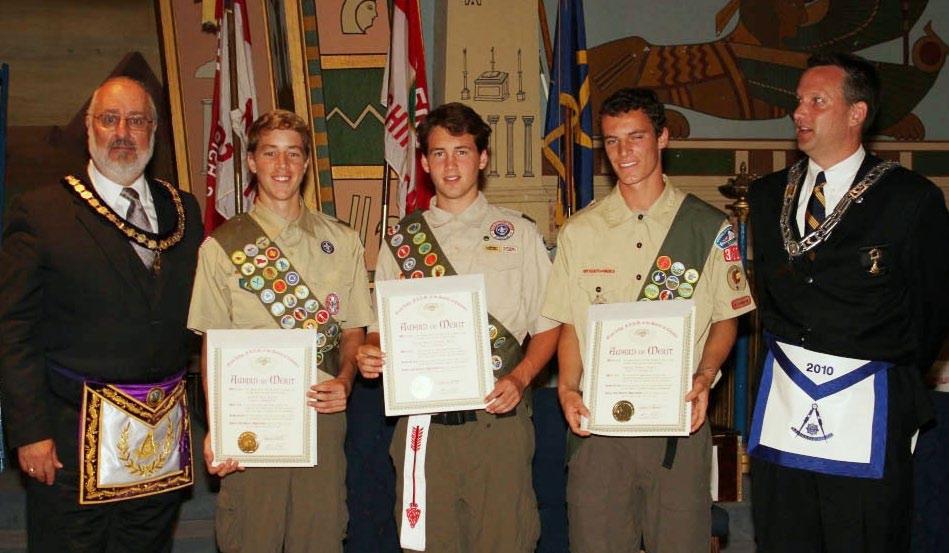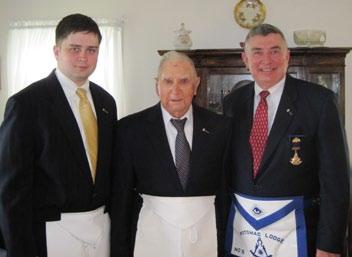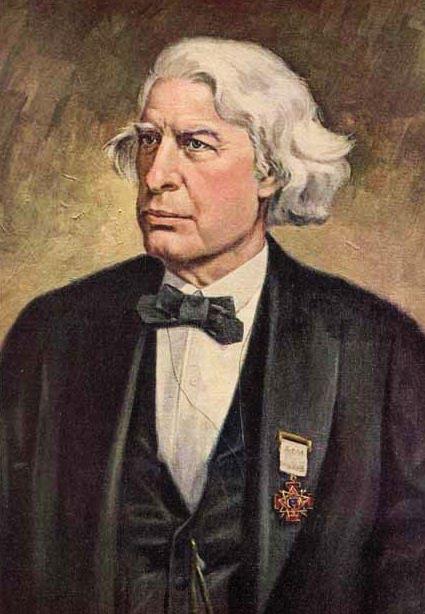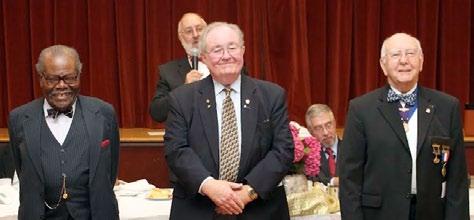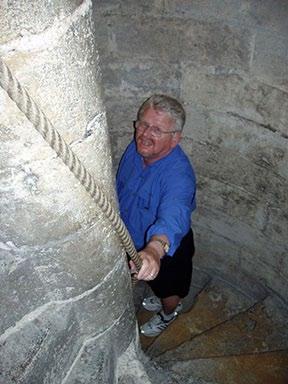
12 minute read
From the Grand Secretary: The Volume of Sacred Law
From the Grand Secretary
The Volume of Sacred Law
Advertisement
In a paper presented at the 2012 Grand Secretaries’ Conference in Atlanta, Georgia, (see “Frontiers of Freemasonry”, The Voice of absolutely required that everywhere the Old and New Testaments shall be Mansour Hatefi, PGM Freemasonry, Volume 20, Number 1, 2012), I used.” Grand Secretary alluded to the fact that the Grand Lodge of the District of Columbia, in response to the rapidly changing demographic in this Jurisdiction, has allowed the addition of alternative books of faith, alongside of the Holy Bible, to the furniture of our constituent lodges. Freemasonry is nonsectarian and non-doctrinal in character. The presence of the VSL, on the altar of a Lodge may, therefore, appear at first glance at odds with this basic concept. The presence of the VSL is no more than a symbol, a representative of all the great Although this practice has long been the norm in books of religious teachings which have particular lodges throughout the world, it is relatively new in significance to particular groups of people. the United States, and as such my reference to the display of the other books of faith sparked a few sideline discussions at the Conference and elicited a few requests for further information. The VSL is a represen tative of all the great books of religious There are seven Volumes of Sacred Law of different faiths in common use in varying numbers. They are in alphabetical order: The Holy Bible (Old Testament) or Tanakh This article is not for the Jews; The Holy intended to be a religious discussion and teachings, which have Bible (Old and New Testament) for Christians; by no means should be construed as an attempt particular significance The Dhammapada, for the Mahayana Sect to deal with the content of sacred writings to particular groups of of Buddhism; The Gita for Hindus; The Grand of any religion or faith. However, it aims to recpeople. Sahib for Sikhs; The Holy Koran for Muslims; ognize that one of the and the Zend-Avesta for hallmark teachings of Zorostians (Parsees). Freemasonry is the universally accepted Masonic Doctrine of the Volume of Sacred Law (VSL). The VSL, whether it be the Holy Bible, the Zend-Avesta, the Holy Koran, or the Gita, typifies the mind or will of The first condition of admission into and memberthe Grand Architect of the Universe. As the VSL ship of the order is a belief in the Supreme Being. is not read in our lodges, its teachings, per se, are The Bible, as the VSL, is always open in Lodges of only symbolic consequence. Its presence in the at labor. Every candidate is required to take his Lodge, however, serves to support the teachings obligation on that book or such other volume that of the two other altar symbols, the Square and is held by his particular creed to impart sanctity to Compasses. an oath or promise taken upon it. Although there seems to be no evidence of any Landmark Twenty First, in part, states that: a definite instructions by the United Grand Lodge “Book of the Law” shall constitute an indispensof England, it is fairly clear the term VSL was able part of the furniture of every Lodge. I say adopted somewhere about 1723, or just after, as a advisedly, a “Book of the Law”, because it is not common title for the holy books of all religions – a
term giving no offense to the adherents of any plicated because customs vary from country to particular religion. This date is significant in that country. A Muslim may touch the Holy Koran with it was at that time the organized craft, previously his bare hands only after having purified himself exclusively Christian, became an ecumenical prior to entering the Lodge after the manner of his organization. religion, and he may only seal it if the holy book of The VSL is the Masonic term for whatever religious or philosophical texts are displayed during a Lodge meeting. Hence, the VSL, to many in the his faith is wrapped up so that the lips do not actually touch it. However, the procedure they use is whatever is customary in their own tradition. western hemisphere is the Christians’ Holy Bible, Men of other religions and or creeds, also differ including the Old and New Testaments. This VSL in their methods of taking an obligation. The Holy most often takes the form of the King James VerBhagavad Gita, a representative Hindu VSL, may sion of the Bible or some be opened and touched other standard translawith the hands, but not tion of the Bible. The Bible was originally only used for obligating candidates. It was not until 1760 that it became part of the “furniture” of the lodges. Since that time it has always been The placing of holy books of other faiths (in addition to the Christian Holy Bible) with the lips. The sealing in this case is realized by placing the hands on the Gita, bringing it to the forehead and then to the chest with the palms together. In the case of Buddhists, opened whenever lodges have been at labor, at on the altars of some and specifically with regards to the Mahayana an appropriate passage Sect, who believe in a in the Old Testament. This practice is acceptlodges under the Supreme Being, (mainly in China, Korea, and able both to Christians and to Jews. jurisdiction of this Japan) the Dhammapada serves as the VSL. If a Lodge has non-Christian members, other texts may be used, and in Lodges with a membership of mixed religions it is common to find more than one sacred text displayed, with the same respect and they are, in every way equal to one another. However, only the Bible is open on the altar and serves as part of the Great Lights. In the District of Columbia, Grand Lodge, came about quite spontane ously and not as the result of any action or edict of the Grand Lodge. However, there is no Buddhist equivalent to the Christian method of taking an oath on sacred scripture. Buddhism is a very tolerant religion and has the greatest respect for the VSL of all religions. It seems therefore that whether or not an obligation sealed thereon is binding depends entirely on the sincerity of the person making the obligation. some lodges display as many as four VSLs, and in Every candidate being initiated and or advancing most lodges in India five to seven VSLs rest on the in his Masonic journey takes an obligation on the altar (or pedestal as the case may be), all open sacred text for his specific religion or the sacred when the Lodge is at labor, and all supporting the writings that candidate derives from his faith and Square and Compasses. moral guidance, which is to bind him to his obligaThe sacred book of the Muslims is the Holy Koran, tions in a most solemn manner. the touching and kissing of which is rather com

To the Jews, Christians, and Moslems, the Volume In the Preamble of the Constitution of the Grand of Sacred Law means the “Word of God”, but again Lodge of District of Columbia, there is a referwithout going into detail, the “Word of God” is ence to the VSL, but the Holy Bible, as it applies different between religions and one should not to Christianity or Judaism, is only mentioned in necessarily extend his take on the “Word of God” relation to Masonic ceremonies. However, since to other faiths. By this I mean that Buddhism the founding of our Grand Lodge, the Holy Bible does not have a written “Word of God” but sets has always been taken to mean the Sacred Book of out to teach its followers about how to obtain that Christianity and one of the Great Lights, and tra“Word”, for themselves. ditionally has been the only holy book mentioned The holy book of any in our ritual at the time of obligating a candidate. religion may be used as The placing of holy books a VSL, provided that it of other faiths (in additeaches and its adherThe holy book of any tion to the Christian Holy ents believe in a Supreme Bible) on the altars of Being. These texts are considered no less holy religion may be used some lodges under the jurisdiction of this Grand to their followers. The perspective of men and as a VSL, provided Lodge, came about quite spontaneously and not as the nature of religion is entirely at the discretion that it teaches and the result of any action or edict of the Grand of the believer. A close reading of the Ritual reveals that the VSL is referred to both as part of the furniture of the Lodge, and also one of the Great Lights. Care must be taken to understand, however, that the VSL is not necessarily the same as the “Great Light” its adherents believe in a Supreme Being. These texts are considered no-less holy to their followers. Lodge. Instead it began in 1990 when the members of one of our newly formed lodges, with a membership of multiple faiths decided that the obligation would be more meaningful if the candidate could take that obligation using the holy book of his own faith. in Masonry. This apparent inconsistency reflects one The perspective of Soon, other lodges adopted the practice, aspect of the develop ment of our ceremonies. men and the nature believing that it made the ceremony more inclusive The sacred writings were first referred to as part of the furniture of the Lodge about 1730. A little later we find the Bible, Square and Compasses described as Pillars of Lodge. The first reference to the VSL, Square and Compasses as the Three Great Lights appears in English writings about 1760, and this usage was confirmed by the Lodge of Reconciliation set up in the early 1800’s to settle differences of practice at the time of the formation of the United Grand Lodge of England. and displayed fraternal appreciation and respect for the particular faith of the individual Mason taking the obligation. Over time, some lodges began placing as many as three other holy books on the altar along with the Holy Bible, although the Holy Bible continues to be the book of scripture which bears the Square and Compasses. The practice varies from lodge to lodge and often reflects the particular lodge’s membership demographics. of religion is entirely the discretion of the believer.

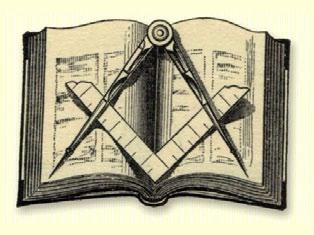
The Grand Lodge of the District of Columbia has taken no official stance on the practice and there is no mention of it in the written laws, regulations, and edicts of the jurisdiction. Lodges are therefore permitted to use or not use books of multiple faiths according to their own preferences and as best befits their circumstances.
Grand Master’s Message continued from page 4
With that background, I think a story of something I saw in Lodge some weeks ago may provide an answer to our question. It was after the raising of some well-inked candidates some weeks ago that we were asking for a blessing of deity upon the brothers, some of whom were not well. And in the darkened Lodge room, I found myself glancing up and finding there my Brother Bilal, a devout Moslem, standing within a short distance from Brother Randy, a Jewish rabbi. To their left stood Brother Daniel, a Christian priest. I wondered – as each stood and invoked the blessings of the deity of his fathers – whether they all felt themselves praying to the same Almighty One, merely under different names. Or perhaps, did each believe that only his prayers were heard, and that he sought to extend the mercies of his deity over the lives and welfares of his brother Masons, as an act of kindness and mercy? Ultimately, I had no answer. And neither does Masonry. Beyond the requirement of a belief in deity, Masonry makes no inquiry into a man’s religious convictions, which are left to him as personal matters of conscience and faith. But it was heartwarming to see that each of these three men found himself free to wish the others well within the context of his own religious convictions, and As Washington, D.C. is truly a cosmopolitan city with a resident population hailing from many lands, near and far, the Grand Lodge, which itself has a diverse membership, has, for at least a couple of decades, been placing three different holy books on its altar at Grand Lodge Communications. The proper Masonic name for the book on the altar even if it is the King James Version of the Bible, is the Volume of Sacred Law. Just as Freemasonry uses the name Great Architect of the Universe to be inclusive of the faiths of all its members, so to should it use the name the Volume of Sacred Law to be inclusive of all books of faith of its members.

None the less, while every Book of Faith, in which has been recorded the way and will of the Great Architect, is enshrined on the altars of our lodges in an increasing number of jurisdictions as the Volume of Sacred Law, the Holy Bible remains the master-book of the Lodge. n
within whatever limits that they may impose upon those wishes. Their peace, and the peace that they wished for their fellows, defined them as brothers. Seeing their willingness to acknowledge their common bond as a part of the family of man, it is unthinkable that any differences in their belief could become a cause for war. And as the sight of their benign union of the moment made me smile – I hope that I was able to share some measure of their peace. So, the answer to our question is “no”. It is not any agreement about the nature or character of the deity that unifies Masons as brothers. Such considerations belong to the world of religion, a world upon which Freemasonry makes no claim. There is, however a more humble agreement, and has to do with our core, social value. Masons are resolved to accept and treat each other as friends and brothers, based upon a common, fraternal experience. That resolution dictates that their conduct exemplifies respect, kindness and brotherly affection, regardless of religious creed. We should all demonstrate such core values, and it’s clear that my Brothers Randy, Bilal and Daniel “wore them on their sleeves” that night. Even if there was no tattoo beneath. n

